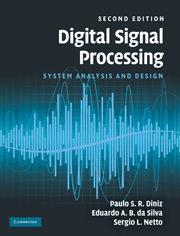Book contents
- Frontmatter
- Contents
- Preface
- Introduction
- 1 Discrete-time signals and systems
- 2 The z and Fourier transforms
- 3 Discrete transforms
- 4 Digital filters
- 5 FIR filter approximations
- 6 IIR filter approximations
- 7 Spectral estimation
- 8 Multirate systems
- 9 Filter banks
- 10 Wavelet transforms
- 11 Finite-precision digital signal processing
- 12 Efficient FIR structures
- 13 Efficient IIR structures
- References
- Index
Introduction
Published online by Cambridge University Press: 05 June 2012
- Frontmatter
- Contents
- Preface
- Introduction
- 1 Discrete-time signals and systems
- 2 The z and Fourier transforms
- 3 Discrete transforms
- 4 Digital filters
- 5 FIR filter approximations
- 6 IIR filter approximations
- 7 Spectral estimation
- 8 Multirate systems
- 9 Filter banks
- 10 Wavelet transforms
- 11 Finite-precision digital signal processing
- 12 Efficient FIR structures
- 13 Efficient IIR structures
- References
- Index
Summary
When we hear the word “signal” we may first think of a phenomenon that occurs continuously over time that carries some information. Most phenomena observed in nature are continuous in time, such as for instance our speech or heart beating, the temperature of the city where we live, the car speed during a given trip, the altitude of the airplane we are traveling in – these are typical continuous-time signals. Engineers are always devising ways to design systems, which are in principle continuous time, for measuring and interfering with these and other phenomena.
One should note that, although continuous-time signals pervade our daily lives, there are also several signals which are originally discrete time; for example, the stock-market weekly financial indicators, the maximum and minimum daily temperatures in our cities, and the average lap speed of a racing car.
If an electrical or computer engineer has the task of designing systems to interact with natural phenomena, their first impulse is to convert some quantities from nature into electric signals through a transducer. Electric signals, which are represented by voltages or currents, have a continuous-time representation. Since digital technology constitutes an extremely powerful tool for information processing, it is natural to think of processing the electric signals generated using it. However, continuous-time signals cannot be processed using computer technology (digital machines), which are especially suited to deal with sequential computation involving numbers.
- Type
- Chapter
- Information
- Digital Signal ProcessingSystem Analysis and Design, pp. 1 - 4Publisher: Cambridge University PressPrint publication year: 2010

